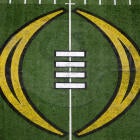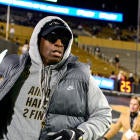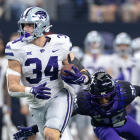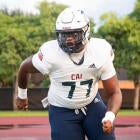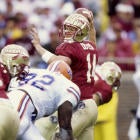During the offseason, there was quiet discussion that could have potentially turned college football's offensive revolution upside down.
The NCAA Football Rules Committee considered making reviewable a long-standing rule that allows offensive lineman to block up to 3 yards downfield on a pass, according to Steve Shaw, NCAA secretary-rules editor.
The 3-yard limit is unique to the college game and is considered the foundation of the run-pass option play that has recast college football in recent years. The so-called "RPO" has allowed offenses to further dominate in a revolution that began about 15 years ago. An RPO essentially allows the quarterback to change the play after the snap with the ball in his hands.
Post-snap, a run can quickly turn into a pass as the quarterback reads the defense. That further confuses defenders keying on lineman already downfield looking like they are blocking for a run.
Kansas City Chiefs offensive lineman Mitch Schwartz explains it for you here.
A Run-Pass Option (RPO) is a called run play with a pass option. It can be a DE, a LB, or just a specific alignment the QB is looking for. The OL blocks for the run the entire way, and the QB makes a decision pre or post snap (depending on which variation is called) to run/throw. https://t.co/Uf0Uev7KHb
— Mitchell Schwartz (@MitchSchwartz72) February 4, 2018
"What makes that call so difficult is you can be up to 3 yards [downfield] when the pass is thrown," Shaw told CBS Sports. "What that means is, at that release point, you've got to frame the field. The umpire -- the guy right behind the defense -- used to be the guy for that. That ball goes overhead and you see a guy 5 yards downfield. You've got to map [the lineman] back to where he was."
Any adjustment in that space has gotten the attention of coaches who have become RPO superstars. Their ability to coach up quarterbacks who can make that post-snap read on the fly has changed the game within the game.
Defensive coaches continue to find difficulty defending the RPO, especially when linemen may or may not be within 3-yard limit.
"We've got great rules right now," said Auburn coach Gus Malzahn, one of the nation's best at running RPO concepts. "Three yards downfield is fair. College football is fine. That's what high school has done. That's what people want to see."
Former Auburn quarterback Nick Marshall's game-tying touchdown pass in 2013 against Alabama is considered one of the most impactful RPO calls ever.
Two years ago, there was discussion by the rules committee of adopting the NFL rule. In the pros, offensive linemen aren't allowed to be more than 1 yard beyond the line of scrimmage when a pass is released. Instead, the rules committee urged officials to "stringently enforce" the 3-yard limit.
RPOs have become so successful there has been obvious backlash. Some coaches claim officials fudge on the 3-yard limit because it is so hard to determine.
Two years ago, then-coordinator of officials Rogers Redding told reporters there would be a "slippery slope of having the [replay] official in the booth create a foul."
"There was conversation in the rules committee, 'Should we make it reviewable?'" Shaw said. "The concern now is, every pass play, [you] put yourself in the replay seat. You can't let the game start unless you review ineligibles downfield."
Current Auburn quarterback Jarrett Stidham had a quick reaction. It's hard to imagine stopping a game every time there is a question whether is improperly downfield. College games are long enough. In 2016, the average length of a game was the longest in history: 3 hours, 24 minutes.
"It would be interesting if that were a rule change," Stidham said. "Games might turn into 5 ½-hour games."
Ole Miss offensive coordinator Phil Longo estimates 50 percent of offenses nationwide incorporate RPO concepts.
"I would never rely on it solely," Longo said. "Defenses are catching up to it. It's a movement that started in football 15 years ago.
"RPOs will be harder to throw this year and will be harder next year."













